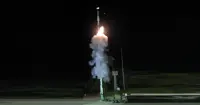Historic launch for ISRO as PSLV-C9 orbits 10 satellites at one go
28 Apr 2008
 In a path breaking mission the Indian Space Research Organisation's (ISRO) Polar Satellite Launch Vehicle (PSLV-C9), successfully launched the 690 kg Indian remote sensing satellite Cartosat-2A, the 83 kg Indian Mini Satellite (IMS-1) and eight nano-satellites for international customers into a 637 km polar sun synchronous orbit. This is for the first time in the world that ten satellites have been launched into orbit in a single mission breaking an earlier record held by Russia, which had injected eight satellites into orbit in a single launch.
In a path breaking mission the Indian Space Research Organisation's (ISRO) Polar Satellite Launch Vehicle (PSLV-C9), successfully launched the 690 kg Indian remote sensing satellite Cartosat-2A, the 83 kg Indian Mini Satellite (IMS-1) and eight nano-satellites for international customers into a 637 km polar sun synchronous orbit. This is for the first time in the world that ten satellites have been launched into orbit in a single mission breaking an earlier record held by Russia, which had injected eight satellites into orbit in a single launch.
This was the PSLV's thirteenth flight and was conducted from the newly built second launch pad of the Satish Dhawan Space Centre (SDSC), Sriharikota (SHAR). The PSLV-C9, in its 'core-alone' configuration, successfully launched ten satellites into orbit, with a total weight of about 820 kg.
 At the end of the 52-hour countdown, the PSLV-C9, with a lift-off mass of 230 tonnes, blasted off from the launch pad and soared into the clear sky in a textbook launch. Fourteen minutes after lift off, the fourth stage of the PSLV-C9 injected all the ten satellites into the 635 km polar sun synchronous orbit.
At the end of the 52-hour countdown, the PSLV-C9, with a lift-off mass of 230 tonnes, blasted off from the launch pad and soared into the clear sky in a textbook launch. Fourteen minutes after lift off, the fourth stage of the PSLV-C9 injected all the ten satellites into the 635 km polar sun synchronous orbit.
This is the third time, the PSLV has been launched in the core-alone version, without the six solid propellant first stage strap-on motors. The earlier core-alone versions had launched satellites into equatorial orbit while this one has put the payloads into a polar orbit, which is also a further validation of ISRO's core-alone technology.
Terming the launch "satisfactory", ISRO chairman, G Madhavan Nair, said "all parameters worked wonderfully well."
After the final count down, PSLV-C9 lifted off from the second launch pad at SDSC SHAR, at 09:24 Hrs IST with the ignition of the core first stage. The important flight events included the separation of the first stage, ignition of the second stage, separation of the heat-shield at about 125 km altitude after the vehicle had cleared the dense atmosphere, second stage separation, third stage ignition, third stage separation, fourth stage ignition and fourth stage cut-off.
The 690 kg main payload, Cartosat-2A, was the first satellite to be injected into orbit at 885 seconds after lift-off at an altitude of 637 km. This was followed about 45 seconds later, with the Indian Mini Satellite (IMS-1)being separated after which all the nano-satellites were separated in sequence.
ISRO said initial signals indicate normal health of the satellites.
Cartosat-2A
 Cartosat-2A is a state-of-the art remote sensing satellite with a spatial resolution of about one metre and swath of 9.6 km. The satellite carries a panchromatic camera (PAN) capable of taking black-and-white pictures in the visible region of electromagnetic spectrum. The highly agile Cartosat-2A is steerable along, as well as across, the direction of its movement to facilitate imaging of any area more frequently.
Cartosat-2A is a state-of-the art remote sensing satellite with a spatial resolution of about one metre and swath of 9.6 km. The satellite carries a panchromatic camera (PAN) capable of taking black-and-white pictures in the visible region of electromagnetic spectrum. The highly agile Cartosat-2A is steerable along, as well as across, the direction of its movement to facilitate imaging of any area more frequently.
Soon after separation from PSLV fourth stage, the two solar panels of Cartosat-2A were automatically deployed. The satellite's health is continuously monitored from the Spacecraft Control Centre at Bangalore with the help of ISTRAC network of stations at Bangalore, Lucknow, Mauritius, Bearslake in Russia, Biak in Indonesia and Svalbard in Norway.
High-resolution data from Cartosat-2A will be invaluable in urban and rural development applications calling for large scale mapping.
Indian Mini Satellite (IMS -1)
Indian Mini Satellite (IMS-1), flown as an auxiliary payload on board PSLV-C9, is developed by ISRO for remote sensing applications. Weighing 83 Kg at lift-off, IMS-1 incorporates many new technologies and has miniaturised subsystems. It carries two remote sensing payloads - a multi-spectral camera (Mx payload) and a Hyper-spectral camera (HySI payload), operating in the visible and near infrared regions of the electromagnetic spectrum.
The spatial resolution of Mx camera is 37 metre with a swath of 151 km while that of HySI is about 506 metre with a swath of about 130 km. The data from this mission will be made available to interested space agencies and student community from developing countries to provide necessary impetus to capacity building in using satellite data.
The versatile IMS-1 has been specifically developed to carry different payloads in future without significant changes in it and has a design life time of two years.
Nano satellites for international customers  Eight nano-satellites from abroad are carried as auxiliary payloads, besides the IMS-1 as well as the Cartosat-2A. The total weight of these nano-satellite payloads is about 50 kg.
Eight nano-satellites from abroad are carried as auxiliary payloads, besides the IMS-1 as well as the Cartosat-2A. The total weight of these nano-satellite payloads is about 50 kg.
Six of the eight nano-satellites are clustered together with the collective name NLS-4. The other two nano-satellites are NLS-5 and RUBIN-8. The NLS-4 is developed by the University of Toronto, Canada, and consists of six nano-satellites developed by various universities.
Two of them - CUTE 1.7 and SEEDS - are built in Japan, while the other four - CAN-X2, AAUSAT-II, COMPASS-1 and DELPHI-C3 are built in Canada, Denmark, Germany and the Netherlands respectively. NLS-5 is also built by University of Toronto and RUBIN-8 is built by Cosmos International, Germany.
The eight nano-satellite payloads of PSLV-C9 are built to develop nano technologies for use in satellites as well as for the development of technologies for satellite applications.
 In its twelve consecutively successful flights so far, PSLV has repeatedly proved itself as a reliable and versatile workhorse launch vehicle. It has demonstrated multiple satellite launch capability having launched a total of sixteen satellites for international customers besides thirteen Indian payloads which are for remote sensing, amateur radio communications and Space capsule Recovery Experiment (SRE-1).
In its twelve consecutively successful flights so far, PSLV has repeatedly proved itself as a reliable and versatile workhorse launch vehicle. It has demonstrated multiple satellite launch capability having launched a total of sixteen satellites for international customers besides thirteen Indian payloads which are for remote sensing, amateur radio communications and Space capsule Recovery Experiment (SRE-1).
The PSLV was also used to launch ISRO's exclusive meteorological satellite, KALPANA-1, into a Geosynchronous Transfer Orbit (GTO) in September 2002 and has proved its versatility. The same vehicle will be used to launch Chandrayaan-1 spacecraft, India's first mission to Moon during this year.































